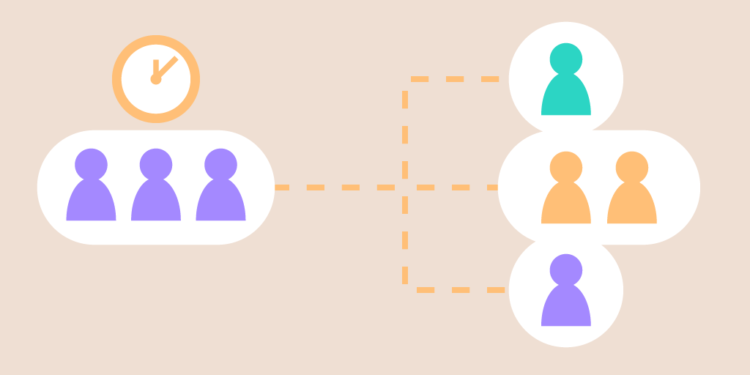Most people spend nearly 6 months of their lives waiting in lines. That’s 180 days of standing in crowded spaces, watching the clock, and hoping your turn comes soon. This may seem like part of everyday life, but it doesn’t have to be. The way we manage queues has evolved—and for businesses, this means creating a smooth customer experience that saves time, keeps staff focused, and allows service to run without interruptions.
Let’s explore how a queue management software works compared to traditional lines, and what difference it can make to your customers, your staff, and your bottom line.
What Is a Queuing System?
A queuing system is a smart way of managing people as they wait for a service using digital tools instead of physical lines.
It replaces the need for customers to stand around waiting with a structured system—either ticket-based, mobile, or screen-based—that guides them through their turn in a more organised way. For businesses, this means fewer service delays, easier customer handling, and improved space management throughout the day.
What Happens in Traditional Lines?
Traditional lines are based on physical presence and guesswork. They often rely on the staff to manually keep things in order.
Without any system in place, customers wait by standing in line, checking frequently if it’s their turn, or asking staff for updates. This setup affects everyone—it slows service, increases pressure on employees, and limits how many people you can serve comfortably during peak hours.
How a Queuing System Helps You Run Things Better
A queue management software changes the entire customer flow from the moment someone enters your space. It adds structure, visibility, and speed to how you operate.
This helps customers know exactly when it’s their turn while allowing your team to focus entirely on the task without managing crowd control. Everyone gets more done in less time—without the usual stress.
Benefits of Using a Queue Management Software
Businesses that switch to a digital queuing system experience a smoother and more organised workday. Here’s what changes when you adopt one:
1. Customers wait better
People feel more relaxed when they know their turn is coming. A ticket number or mobile alert gives them confidence instead of making them stand and guess.
2. Staff become more productive
Instead of answering the same “How long will it take?” questions, employees focus on their main job. The system handles the order.
3. Service is faster and cleaner
The moment a customer finishes, the next one is already queued up—without confusion or delays.
4. Peak hour pressure gets handled easily
Real-time dashboards help you manage flow during busy hours. This improves scheduling and reduces wait times.
5. Reports help you make decisions
Queue software shows you how long people wait, what services take longer, and where resources need to be adjusted.
Queuing System vs Traditional Lines: A Simple Comparison
There are clear differences in how both methods operate. One relies on memory and physical presence, while the other works on logic, clarity, and planning.
This table highlights where each one stands:
| Feature | Traditional Lines | Queuing System |
| Wait Handling | Physical presence | Virtual or token-based |
| Staff Involvement | High | Minimal |
| Customer Order | Verbal or assumed | Automatically managed |
| Real-Time Updates | None | Available on screen or mobile |
| Reporting Tools | Not present | Fully available |
| Remote Access | Not possible | Yes, via app or SMS |
Common Places Where Queuing Systems Work Best
Digital queue systems work across different industries. Anywhere people come in for a service, they help simplify the experience.
Healthcare and Clinics
Patients feel more at ease when they know when they’ll be seen. It also prevents waiting room crowding and helps medical staff manage their time better.
Banks and Financial Services
Banks deal with different customer needs—some take minutes, others longer. A queue system sorts visitors by purpose and directs them smoothly.
Retail Stores and Service Centres
During sales or repairs, service counters get packed quickly. Queue software brings order, assigns customers, and makes sure no one is skipped.
Government Offices
From passport counters to municipal services, queues often stretch. A digital flow system improves citizen satisfaction and daily output.
Educational Institutions
During admissions or events, institutions see heavy walk-ins. Queuing systems manage large groups without delays or confusion.
Features That Make a Queuing System Work Well
The effectiveness of a queue solution depends on what it offers your business. A good system comes with flexible tools that match your real-world needs.
Flexible check-in options
Let people join the queue using kiosks, QR codes, apps, or booking links. It reduces bottlenecks at entry points.
Real-time updates
Screens or SMS alerts keep everyone informed without repeated questions. It also keeps waiting areas calm.
Custom service flows
You can create single queues, multi-service points, or priority lanes depending on your business type.
Remote monitoring
Managers get insights from a dashboard that shows queue lengths, average wait times, and live staff activity.
Feedback collection
You can ask for ratings right after the customer is served. It helps track service quality.
Why You Don’t Need to Be a Large Business to Use One
Many small businesses assume that digital systems are only for large spaces with hundreds of visitors. That’s not the case.
Even a small dental clinic, a passport helpdesk, or a customer support desk at a mobile store can benefit from structured queues. This would give your visitors a sense of flow.
Customers appreciate clarity. Staff enjoy working in a calm, predictable environment. It’s a win for everyone involved.
Final Word
Customer-facing spaces work best when people know what to expect and feel like their time is valued. A queuing system helps you deliver just that. It builds confidence, clears confusion, and improves how people experience your service.
If your business sees regular foot traffic and you’re looking for ways to improve customer flow, simplify daily operations, and reduce stress for your team, this is the system to consider.
NEMO-Q offers custom-designed queue management software that suits clinics, banks, stores, and institutions of all sizes. With over 40 years of experience, NEMO-Q helps businesses create efficient, welcoming spaces that run on time—every time.





